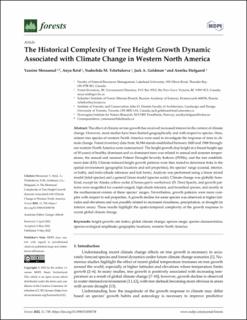The Historical Complexity of Tree Height Growth Dynamic Associated with Climate Change in Western North America
| dc.contributor.author | Messaoud, Yassine | |
| dc.contributor.author | Reid, Anya M. | |
| dc.contributor.author | Tchebakova, Nadezhda M. | |
| dc.contributor.author | Goldman, Jack A. | |
| dc.contributor.author | Hofgaard, Annika | |
| dc.coverage.spatial | Western North America | en_US |
| dc.date.accessioned | 2022-06-29T12:51:22Z | |
| dc.date.available | 2022-06-29T12:51:22Z | |
| dc.date.created | 2022-05-10T10:20:03Z | |
| dc.date.issued | 2022 | |
| dc.identifier.issn | 1999-4907 | |
| dc.identifier.uri | https://hdl.handle.net/11250/3001574 | |
| dc.description.abstract | The effect of climate on tree growth has received increased interest in the context of climate change. However, most studies have been limited geographically and with respect to species. Here, sixteen tree species of western North America were used to investigate the response of trees to climate change. Forest inventory data from 36,944 stands established between 1600 and 1968 throughout western North America were summarized. The height growth (top height at a breast‐height age of 50 years) of healthy dominant and co‐dominant trees was related to annual and summer temperatures, the annual and summer Palmer Drought Severity Indexes (PDSIs), and the tree establishment date (ED). Climate‐induced height growth patterns were then tested to determine links to the spatial environment (geographic locations and soil properties), the species’ range (coastal, interior, or both), and traits (shade tolerance and leaf form). Analysis was performed using a linear mixed model (total species) and a general linear model (species scale). Climate change was globally beneficial, except for Alaska yellow‐cedar (Chamaecyparis nootkatensis (D. Don) Spach), and growth patterns were magnified for coastal‐ranged, high‐shade‐tolerant, and broadleaf species, and mostly at the northernmost extents of these species’ ranges. Nevertheless, growth patterns were more complex with respect to soil properties. A growth decline for some species was observed at higher latitudes and elevations and was possibly related to increased cloudiness, precipitation, or drought (in interior areas). These results highlight the spatio‐temporal complexity of the growth response to recent global climate change. height growth; site index; global climate change; species range; species characteristics; species ecological amplitude; geographic locations; western North America | en_US |
| dc.language.iso | eng | en_US |
| dc.rights | Navngivelse 4.0 Internasjonal | * |
| dc.rights.uri | http://creativecommons.org/licenses/by/4.0/deed.no | * |
| dc.subject | height growth | en_US |
| dc.subject | site index | en_US |
| dc.subject | global climate change | en_US |
| dc.subject | species range | en_US |
| dc.subject | species characteristics | en_US |
| dc.subject | species ecological amplitude | en_US |
| dc.subject | geographic locations | en_US |
| dc.subject | western North America | en_US |
| dc.title | The Historical Complexity of Tree Height Growth Dynamic Associated with Climate Change in Western North America | en_US |
| dc.title.alternative | The Historical Complexity of Tree Height Growth Dynamic Associated with Climate Change in Western North America | en_US |
| dc.type | Peer reviewed | en_US |
| dc.type | Journal article | en_US |
| dc.description.version | publishedVersion | en_US |
| dc.rights.holder | © 2022 The Authors | en_US |
| dc.subject.nsi | VDP::Zoologiske og botaniske fag: 480 | en_US |
| dc.subject.nsi | VDP::Zoology and botany: 480 | en_US |
| dc.source.volume | 13 | en_US |
| dc.source.journal | Forests | en_US |
| dc.identifier.doi | 10.3390/f13050738 | |
| dc.identifier.cristin | 2022961 | |
| dc.source.articlenumber | 738 | en_US |
| cristin.ispublished | true | |
| cristin.fulltext | original | |
| cristin.qualitycode | 1 |
Tilhørende fil(er)
Denne innførselen finnes i følgende samling(er)
-
Publikasjoner fra CRIStin - NINA [2314]
-
Scientific publications [1342]
Vitenskapelige artikler, kapitler og monografier i Open Access.

